Can You Upload Blender Models Into Fusion
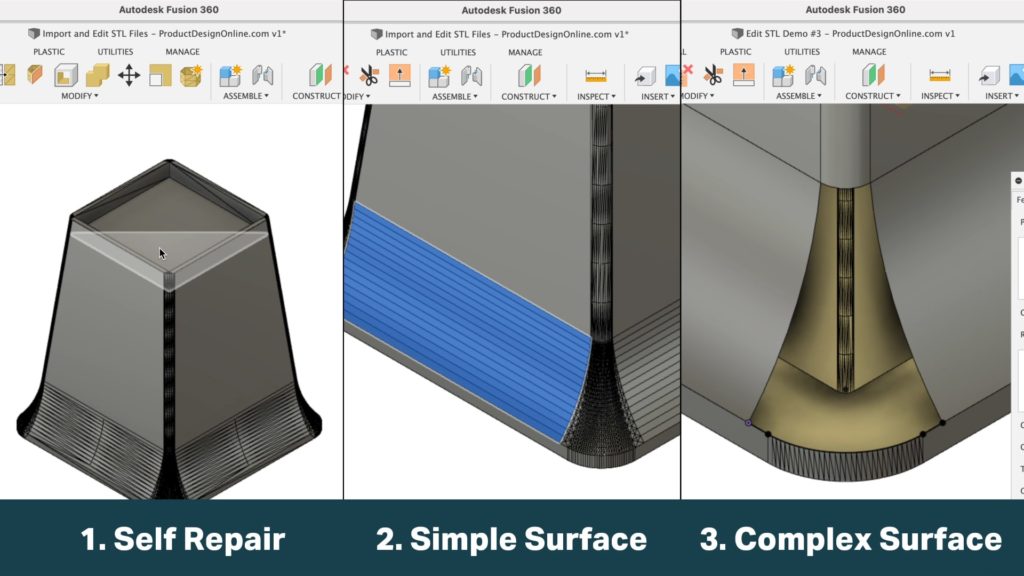
3D printing hobbyists looking to convert STL files to solid BREP bodies can utilise Fusion 360. This includes the use of Fusion 360's free Personal Use license. However, it's of import to notation that those on the costless license will not take access to the Prismatic conversion blazon.
In short, the Prismatic conversion (released July 2021) will automatically translate almost mesh files to a solid torso, as if it were created natively in Fusion 360. The largest advantage is that it saves time and effort from having to clean upward mesh triangles (i.e. mesh facets) that result from the original Faceted conversion method.
The Faceted conversion method remains complimentary to all license types, including the Fusion 360 Personal Use ("Hobby") license. Cleaning upward the mesh triangles, oft referred to as 'facets,' can be done direct in Fusion 360. This allows you to add text or alter the dimensions or parts of a model, without having to recreate the model from scratch. That said, there will be times when cleaning up the STL file is not worth it, when compared to recreating the model from scratch in a truly parametric fashion.
The following tutorial and demo files will assist you learn how to import STL mesh files, catechumen the mesh files to solid BREP bodies, and clean up those pesky mesh triangles.
The techniques outlined below range from beginner to more avant-garde concepts, all of which are covered in the lesson.
- Import STL in Fusion 360
- Edit and Make clean Upwards STL Files – 3 Workflows
- Demo Files
- Video Tutorial
- Transcript
Import STL in Fusion 360
To convert your STL or mesh file in Fusion 360, you volition want to insert it via the Insert Mesh command. Ever avert uploading your STL to the Fusion 360 Data Console, which does not let you to set the Unit Blazon or reorient the model.
- In the Solid tab of the Blueprint Workspace, select the Insert Mesh command from the Insert bill of fare.
- A dialog will open. Select the desired mesh file from your local computer > Open.
- Prepare the Unit of measurement Type, Reorient the Model (Flip Upwards Direction), and Position the model > OK.
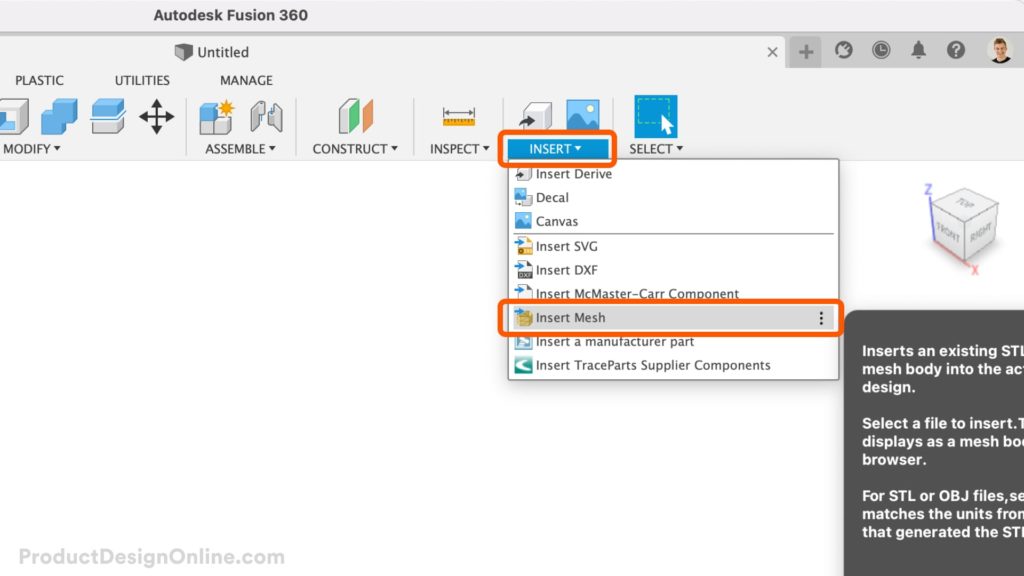
Edit and Make clean Up STL Files – 3 Workflows
You can utilize the post-obit 3 workflows, which are covered in-depth in the video tutorial, to remove and clean up STL mesh triangles. These workflows range from beginner to advanced and results will vary per each individual STL file.
In general, if the model is something that you could create in Fusion 360 (or an equivalent parametric modeling plan), and then it is possible to remove the mesh triangles. If the model is organic – originally created in a mesh modeling programme (Blender, Maya, etc) – then there's a good gamble that this procedure will not work.
Proceed in listen that cleaning up STL mesh triangles is not required in order to accept successful 3D prints. A common myth is that the mesh triangles will bear on the effect of the 3D print. However, this is only true if you reduce the number of mesh triangles that brand upwardly the shape.
Otherwise, the mesh triangle is simply visual in the editing software (Tip: modify your Visual Manner to "Shaded" to take a look).
Your goal should be to remove just the necessary mesh triangles to add text or modify the size or shape of the model.
Workflow #1: Cocky-Repair Planar Faces (Beginner)
Select whatsoever planar face, followed by the Delete key. Fusion 360 will effort to self-repair all adjacent planar faces. Most often, this volition quickly upshot in a single planar face. Withal, note that this approach is non e'er an choice when as well many faces are present. In some cases, planar faces may appear to be on the same aeroplane, but they will not cocky-repair if they are ever-so-slightly off the plane.
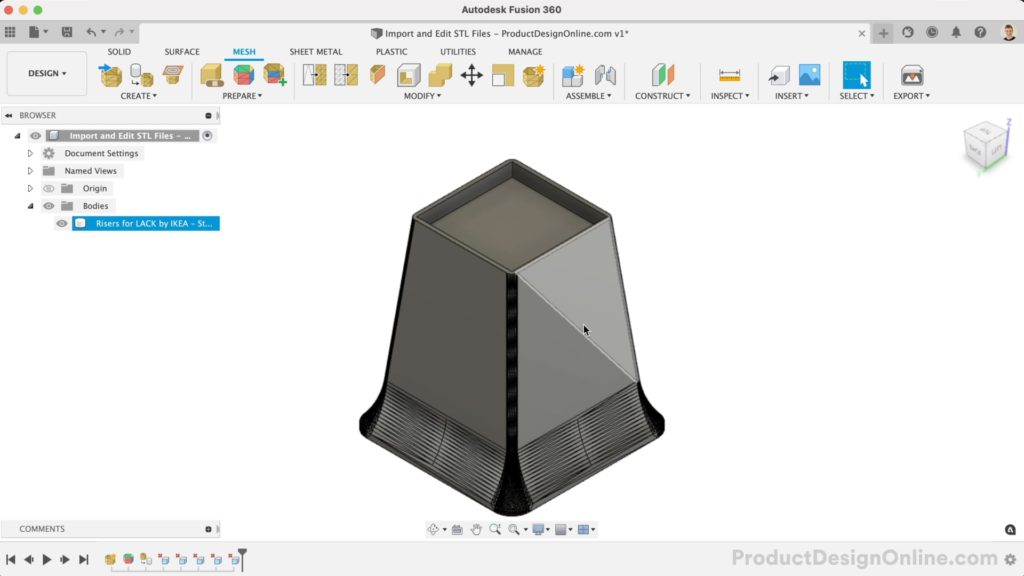
Workflow #ii: Surface Model Single Curves (Intermediate)
Singular curves tin can often be recreated quickly using Fusion 360's surface modeling tools. These tools include the Patch and Extrude commands. In some cases, you lot may be able to reference existing surfaces, edges, or sketches to rapidly recreate the surface. If not, yous volition want to create reference geometry through the employ of a new sketch that includes Projected geometry.
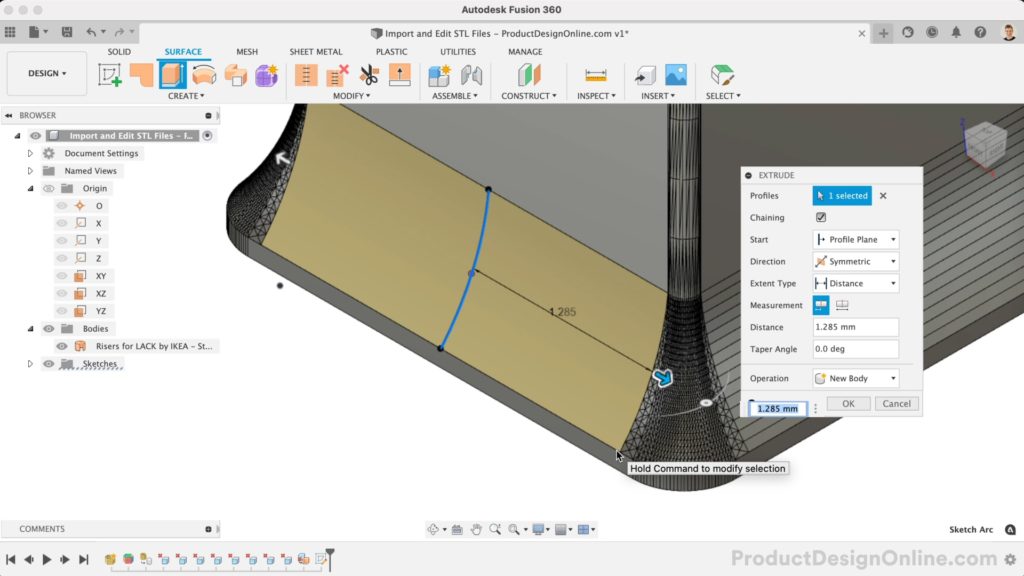
Workflow #three: Surface Model Complex Curves (Advanced)
Almost all "complex" surfaces can be created with either a Sweep or Loft. The geometry bachelor to reference will help determine which approach to use. In many cases, you volition want to break your parts into smaller sections, making it easier to recreate the surfaces.
Use Project and Intersect to ensure the surfaces are touching the next faces. This step will be critical to help the procedure of "Stitching" the model together at the end – ultimately, leaving you lot with a solid BREP trunk.
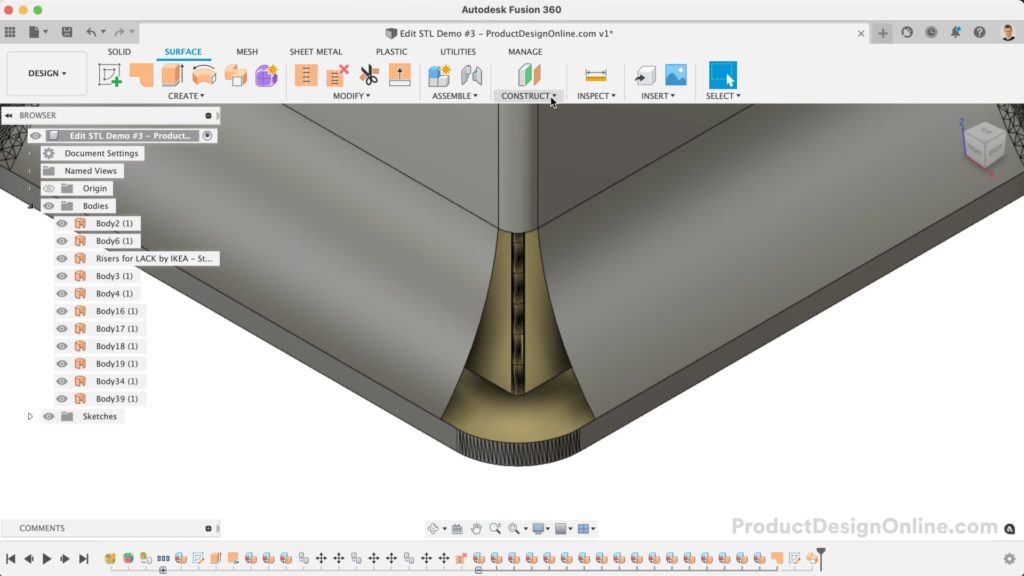
Demo Files
Utilize the following three demo files to follow forth with the tutorial. During the tutorial video, I will call out when to use the next demo file to save you time from having to complete the laborious steps. Of course, you're too welcome to consummate all the steps on your own using the first demo file.
The demo files are all available for gratuitous via the PDO portfolio on Thangs.com. Of import: Yous will need to catechumen each demo file with the Convert Mesh command in Fusion 360, using the 'Faceted' arroyo. This procedure is covered at the beginning of the Import and Edit STL tutorial.
- Demo File #i – IKEA LACK Risers Standard
- Demo File #2 – IKEA LACK Riser with Uncomplicated Curved Removed
- Demo File #3 – IKEA LACK Riser with Complex Curves Removed
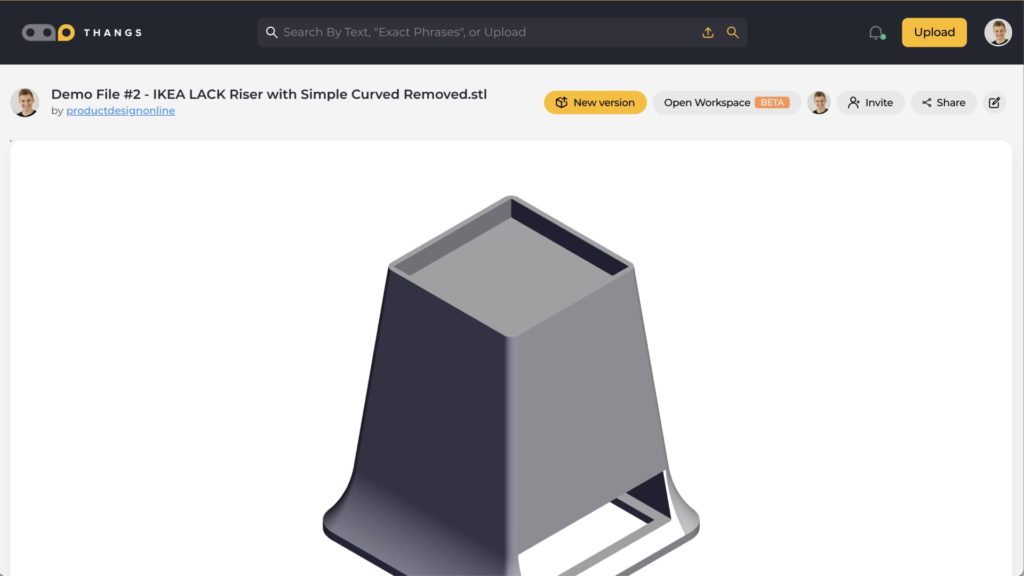
Video Tutorial – Import and Edit STL Files in Fusion 360 (2022)
Transcript
3D Printing hobbyists looking to remix STL files tin can clean up those pesky triangles using the following 3 techniques in Fusion 360. These range from beginner to more than avant-garde difficulty. I'll evidence you all three, including a manner to version-control your STL files. The methods in this lesson are for those on the free Personal Utilise license without access to the newer Prismatic conversion.
To import your mesh file, e'er apply the Insert Mesh command from the Insert dropdown carte du jour instead of uploading your mesh file to the Data Panel. The insert workflow is best every bit it allows yous to select the desired unit type. We can also use the rotation manipulators to reorient the model, followed past re-centering it to the origin betoken of our file.
While in the Design workspace, nosotros'll head to the Mesh tab.
I'll catechumen this tabular array riser for an IKEA LACK table. Get the file link in the video description.
First, we'll want to Generate Confront Groups. This feature will detect groups of faces representing a feature or region of the mesh body. Using the Accurate option will provide the all-time results.
If y'all don't run into the pastel colors, you'll want to turn on Face up Groups in the Mesh Display settings. Notice how this has color-coded the model to show all the faces that relate to one another.
You will find a Convert Mesh command in the Modify menu of the Mesh tab. Double-cheque that yous're in the Mesh tab if y'all don't see the Convert Mesh feature. Yous tin also printing the keyboard shortcut letter "S," as in Sierra, to search for Convert Mesh.
After selecting the mesh body, you'll want to choose whether you desire the feature to exist parametric and recorded in the timeline below. Or, for it to exist a base feature if yous plan to work with a straight editing approach. Generally, you'll desire this to be parametric, allowing yous to update or remove features after.
If you lot're on the costless Personal Use or "Hobby" license, yous'll have no option only to utilise the Faceted approach. Those on all other license types can apply the Prismatic version, which you'll find volition automatically convert most models to a clean and solid bRrep body, as if nosotros created information technology natively in Fusion 360.
Back in the Convert Mesh characteristic, annotation that at that place is also a new Organic option. This method converts organically shaped meshes to solid, surface, or T-spline bodies. Even so, it is merely available through the new Product Design extension.
Permit's go along with the gratis Faceted method, and we'll look at how to clean up the mesh triangles.
For starters, double-check the bodies binder in the Fusion 360 Browser. Your file should be a solid trunk, as indicated by the gray cylinder. If y'all concluded up with an orange surface body, yous'll have to find and shut the openings.
The beginning and easiest method to clean upwards these triangles is to select a planar face and press the Delete key.
Fusion 360 will attempt to self-repair all next planar faces, resulting in a single confront. This will provide you with a clean planar confront to create a new sketch on. You tin can also Extrude or Offset faces to alter the dimensions.
One important note – you may observe that showtime faces will limit the size due to curvature or adjacent faces. Y'all can avoid this by turning off the parametric timeline to enter Direct Modeling mode. You'll find Directly editing to be more forgiving, but keep in mind that you lot practise lose the parametric timeline and your ability to update any previous and future actions.
This delete faces approach does not piece of work on any curved surfaces, equally reducing the number of faces volition modify the curvature itself. Instead, we'll take a look at workflow number two, which is to use the orange Surface Extrude to rebuild uncomplicated curvature, such as this singular curved surface.
We can utilise the selection filters to plough off everything except Body Faces. Double-bank check the select through option is turned off to ensure we don't select faces on the opposite side of our model.
We can and then use the Paint Selection type by clicking on the Canvas – outside the model – and dragging over the desired faces.
Hold CMD on Mac or CTRL on Windows and click with your mouse to deselect whatever unwanted faces. And so, extremely disquisitional, y'all must switch to the Surface modeling tab before pressing the Delete primal.
Deleting while in the Surface tab will remove all of these outer faces, resulting in a surface body. Nosotros'll at present recreate this curve with a single surface.
To close the gap, you may exist able to reference existing geometry with a surface Extrude. Nevertheless, in this case, it leaves us with many faces. We can instead create a new sketch with projected reference points, assuasive usa to create a clean surface.
I'll create a new sketch from the YZ origin airplane. Creating this in the middle allows united states to leverage the symmetric extrude type.
With Project, I'll projection the top and lesser points. Then, most importantly, we can recreate this verbal geometry with a 3-point arc, so we'll Projection a point in the center as well. If you're not familiar with the Project and Intersect commands, be sure to watch my full lesson on them. Utilizing Project will be critical in rebuilding the surfaces of your mesh files.
With a 3-point arc, nosotros tin can speedily recreate that verbal surface.
Using the surface Extrude set every bit symmetric, we can extrude upwards to the edge by selecting the corner betoken. Every bit you rebuild your files, consider how y'all may rebuild surfaces with the simplest geometry. You volition demand to pause the object into multiple sections.
Note this surface is within out, as noted by the xanthous colour. Use Opposite Normal to flip the surface.
Many models will include symmetry or the same geometry throughout. In this case, we can delete the faces of the other three curves.
If you'd like to follow forth, you can employ Demo File number 2. This file is fix with the other three surfaces removed.
The rebuilt surface however exists on its ain in the Browser. This allows us to re-create and paste using the standard shortcuts.
And then, you'll find it very easy to identify these into position by rotating them ninety degrees, followed by the Bespeak to Point Move Type. Bespeak to Betoken allows you lot to select the bespeak y'all want to motion equally the "Origin," along with the target point. Which corners you choose does not matter, equally long as they correspond to 1 some other. Just repeat this process for the remaining ii surfaces.
Now on to the third and about avant-garde method. If the model was originally built in Fusion 360 or an equivalent parametric programme, so virtually all of the geometry can exist rebuilt with a surface Sweep or surface Loft commands.
Offset, enquire yourself if it's easier to rebuild the model from scratch. In many cases, information technology may exist worth the bit of extra time to have a truly parametric model.
If non, consider how you can split up the model up into sections that can exist rebuilt with sweeps and lofts.
Fillets with single curvature can be rebuilt with the Sweep command. For example, nosotros'll rebuild the side of this table riser.
Here's a handy trick if you need to delete a large number of mesh facets. We can use the Unstitch feature to unstitch the side by side faces. Doing so will allow us to hide them in the Browser, making information technology easier for the states to use a choice window to select all mesh triangles we'd like to delete.
For your convenience, you tin as well grab demo file number 3, which has this section removed for you.
To create the sweep, we'll demand a sketch profile. In this case, we'll sketch on the meridian surface to recreate the curvature.
Projecting the two side by side lines will allow yous to use the Tangent arc, ensuring there is tangency in the transition to the side by side planar faces.
Using the surface Sweep command, we can now use this sketch as the contour, and the existing border of our planar face as the Sweep path.
The next objective is to use a more complex surface Loft to fix the complex curvature at the lesser.
Lofting will by and large require yous to create one or more than sketches to reference as the guide rails. In this case, we can loft from one side to the other, while referencing the pinnacle and the lesser as rails. However, considering the lesser surface was not yet cleaned upwards, we'll need to create a sketch to employ as the rail.
With a Plane at Angle or Airplane through Three Points, nosotros tin can create a Construction Plane to create the sketch on.
Once again, yous'll want to Project relevant geometry that will aid you rebuild the surface. In this case, Project the corner edges and the start of the curve on each side.
We can depict lines for the two straight segments. Once once again, I'll utilise the Tangent Arc to ensure this geometry is tangent to the adjacent faces. Double-check that both tangent constraints applied correctly. You lot may have to manually apply them in some scenarios.
With the Surface loft, we tin at present use the top and lesser as the track later selecting the ii side profiles. Keep an eye on Concatenation Faces, which will ensure the sketch objects are selected every bit a single entity. You will also want to consider Continuity. We'll switch this to Tangent (G1), which ensures the new surface is tangent to the adjacent surfaces.
You'll also want to familiarize yourself with the diverse Analysis options that will help you ostend your geometry is right and make clean.
Once all your desired surfaces are rebuilt, we demand to stitch them together to turn this model dorsum to a solid torso. Keep in mind that you practice non accept to recreate all surfaces, only the ones that you intend to modify and in some cases, any adjacent surfaces. As long as yous do not reduce the number of mesh facets, the triangles do non actually affect the quality of the final model.
I recommend viewing your model with the Shaded visibility to check geometry throughout any of these workflows.
With the Stitch control active, you'll notice the red areas highlighted afterward we select the main body. Selecting each boosted surface torso in the Browser, you lot'll find the highlights plow greenish, indicating that the surfaces are touching.
We'll also want to set the tolerance. I recommend .01mm which volition help shut the surfaces without distorting them.
Notice nosotros concluded up with a unmarried solid torso in the Browser. You're now able to modify this equally a solid body, utilizing the full suite of solid modeling tools.
If you're okay with losing your parametric timeline, yous can apply the Discover Features command in the direct modeling way. This may make information technology easier to remove or alter common features such equally Extrude and Fillet.
I as well desire to show you lot how to use Thangs' new Workspace to version command your files outside of Fusion 360. In that location's e'er room for improvement after testing 3D prints, and I believe this workflow may help yous keep track of changes and manage your files without crazy naming conventions.
From your Thangs.com Profile, select View My Thangs. You can then select the desired file and "Open up Workspace."
Thangs Workspace is 100% free and includes unlimited storage, sharing, and collaboration features.
Drag and drop the latest file and select Proceed.
1 of my favorite features is the power to add a version description. Allow your teammates or others recognize the improvements or changes. We tin can then Publish the new version.
Information technology's of import to annotation that Workspace works with all of your individual files, also as your Public files. Your files do not take to be public to utilise these features.
From the Overview tab, compare differences side by side. However, in some cases, the changes may be hard to spot. The Overlay selection allows y'all to drag the slider to transition from the latest to the new version. Notice the model turns solid green as it shows the new version.
Lastly, the X-ray characteristic allows you to quickly view whatever internal changes. This also calls out features that may accept been removed or added, and y'all can toggle these options at whatsoever time.
All of these features can be activated from the desired version in your version history. Simply select to view the difference.
It's also important to annotation if your model is already made public, then your new version volition be made public immediately, so don't upload the version until you're ready…or you lot can always first alter the model to be private.
Thangs' new Workspace features also work hand-in-paw with their existing storage and collaboration features. Invite teammates to individual folders and assign tasks based on each version or office. This makes working on collaborative projects much easier.
If you've learned something in this video, then you tin aid me out by clicking that thumbs-up button and sharing this video with your young man 3D printing hobbyists.
You'll also discover additional 3D printing design lessons in the following playlist.
Source: https://productdesignonline.com/import-and-edit-stl-files-in-fusion-360-2022/
0 Response to "Can You Upload Blender Models Into Fusion"
Post a Comment